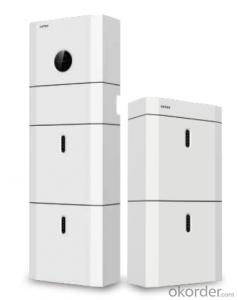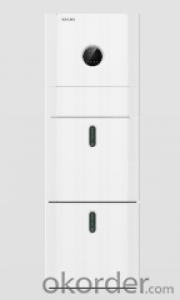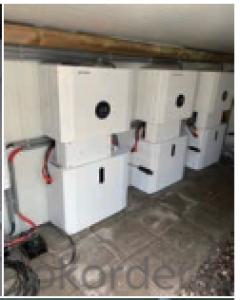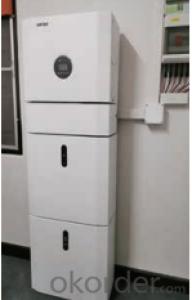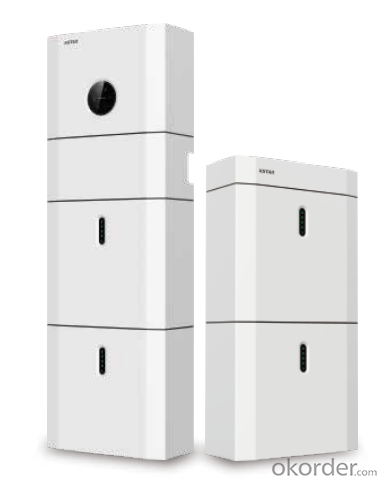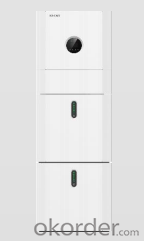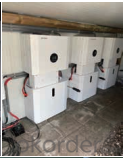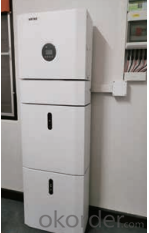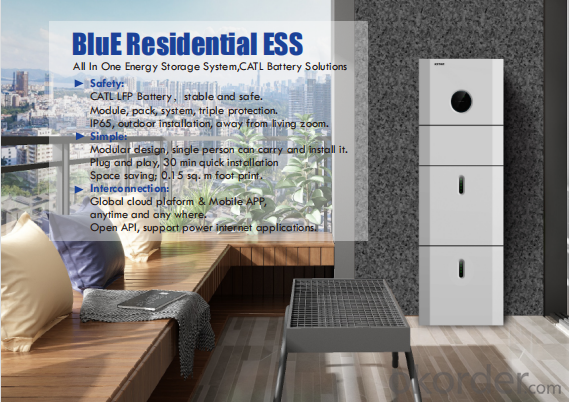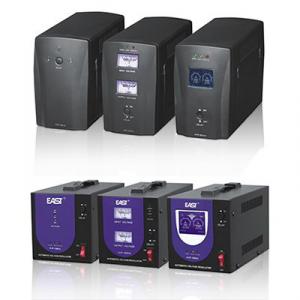All In One Energy Storage System BluE Residential ESS
- Loading Port:
- China main port
- Payment Terms:
- TT OR LC
- Min Order Qty:
- 50 pc
- Supply Capability:
- 15000 pc/month
OKorder Service Pledge
OKorder Financial Service
You Might Also Like
Specification
Product Description:
Safety:
★CATL LFP Battery,stable and safe.
★Module, pack, system, triple protection.
★IP65, outdoor installation, away from living zoom.
Simple:
★Modular design, single person can carry and install it.
★Plug and play, 30 min quick installation.
★Space saving; 0.15 sq. m foot print.
Interconnection:
★Global cloud plaform & Mobile APP, anytime and any where.
★Open API, support power internet applications.
Technical Specifications:
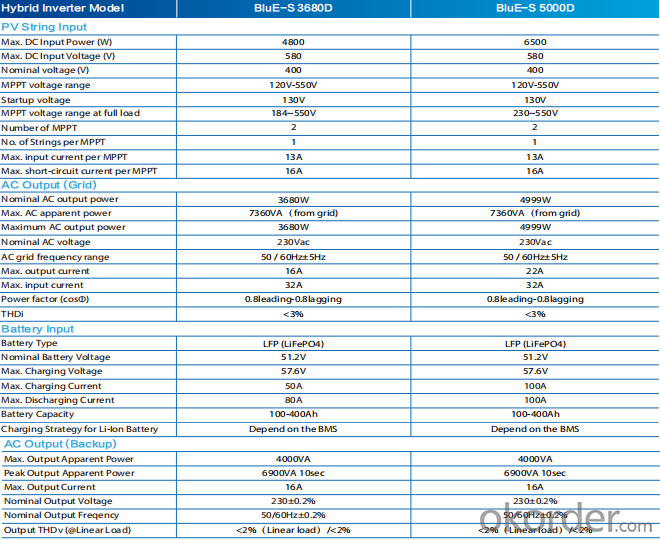


FAQ:
Q:How the output voltage of the PV inverter and the grid-connected voltage are determined
Inverter is the DC power (battery, battery) into alternating current (usually 220V, 50Hz sine wave). It consists of inverter bridge, control logic and filter circuit. Widely used in air conditioning, home theater, electric wheel, power tools, sewing machines, DVD, VCD, computer, TV, washing machine, range hood, refrigerator, video recorders, massage, fan, lighting and so on. In foreign countries
Q:Installation and maintenance of photovoltaic grid - connected inverter
only when the local power sector permission by the professional and technical personnel to complete all the electrical connection before the inverter can be connected.
Q:What is the difference between a PV grid-connected inverter and an off-grid inverter?
Off-grid inverter is equivalent to their own to establish an independent small power grid, mainly to control their own voltage, is a voltage source.
Q:After the PV inverter, how to achieve the same period before the network?
Solar panel simulator: with MPPT function, simulated morning, noon, afternoon, evening, rainy weather, solar panels produced under different conditions in different voltages.
Q:Is the PV inverter a current source or a voltage source?
According to the waveform modulation method can be divided into square wave inverter, stepped wave inverter, sine wave inverter and modular three-phase inverter.
Q:Photovoltaic grid-connected inverter without DC emc how will happen
Solar photovoltaic power generation technology is the use of solar cells, the photovoltaic effect of semiconductor materials, solar radiation can be directly converted into a new type of power generation system, solar energy is a radiant energy, solar power means --- to direct conversion of sunlight Into electricity,
Q:What is the difference between low voltage grid connection and medium voltage grid connection?
For photovoltaic power plants when the power system accidents or disturbances caused by photovoltaic power plant grid voltage drop, in a certain voltage drop range and time interval, the photovoltaic power plant can ensure that non-off-line continuous operation.
Q:Is the grid side of the grid and the inverter?
The grid load side of the grid is the grid. The inverter is an important part of the PV grid-connected system and can not be regarded as an external load. Photovoltaic power generation system is included in both grid and off-grid.
Q:PV grid-connected inverter and independent inverter in the control of what is the difference
The independent inverter in the output voltage phase amplitude of the frequency control is initially set good. Independent inverter, you should refer to off-grid inverter, do not need to consider the grid situation.
Product Images:

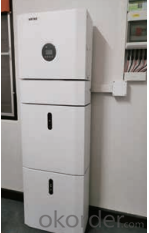
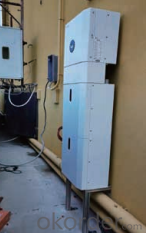
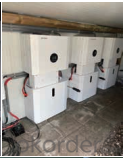
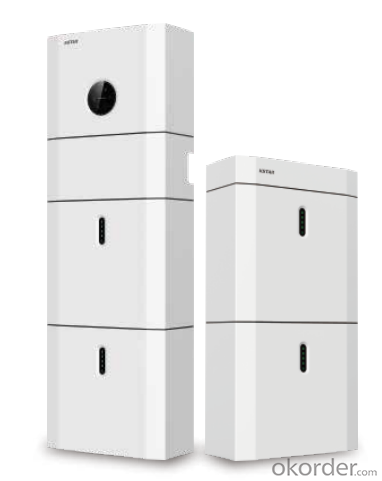
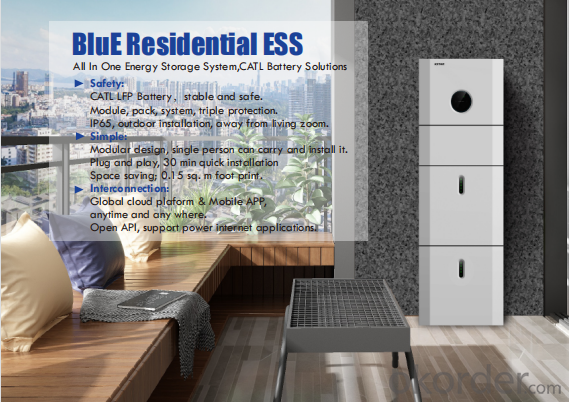



Production Process Photos:

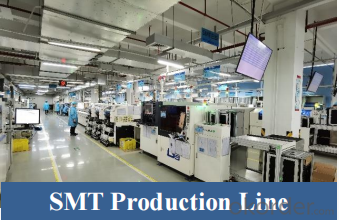
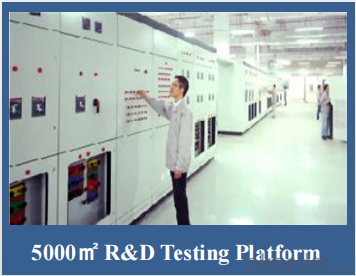
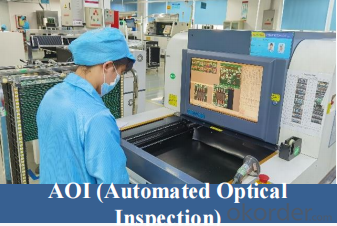
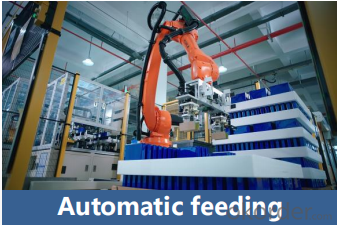
- Q: What is the role of a solar inverter in preventing electrical faults?
- The role of a solar inverter in preventing electrical faults is to convert the direct current (DC) generated by solar panels into alternating current (AC) that can be used by appliances and the electrical grid. By regulating and controlling the flow of electricity, a solar inverter ensures that the voltage and frequency levels are within acceptable limits, preventing overloading, overheating, and electrical faults that could potentially damage the system or cause safety hazards.
- Q: What are the safety considerations when installing a solar inverter?
- Safety considerations when installing a solar inverter include ensuring proper electrical grounding, following manufacturer's instructions and guidelines, using appropriate personal protective equipment, avoiding contact with live electrical components, testing the system for proper operation before energizing, and complying with local electrical codes and regulations.
- Q: Can a solar inverter be used with different types of solar tracking systems?
- Yes, a solar inverter can be used with different types of solar tracking systems. Solar inverters are designed to convert the direct current (DC) produced by solar panels into alternating current (AC) for use in homes or businesses. They are compatible with various solar tracking systems, including single-axis and dual-axis trackers, as long as the voltage and power ratings of the inverter match the requirements of the specific tracking system.
- Q: Can a solar inverter be used in a solar-powered air conditioning system?
- Yes, a solar inverter can be used in a solar-powered air conditioning system. A solar inverter converts the direct current (DC) produced by solar panels into alternating current (AC), which is required to power most appliances including air conditioning units. By using a solar inverter, the solar energy generated by the panels can be efficiently utilized to run the air conditioning system, reducing reliance on the electrical grid and lowering energy costs.
- Q: Can a solar inverter be used with different solar panel technologies?
- Yes, a solar inverter can be used with different solar panel technologies as long as the inverter is compatible with the specific voltage and power output of the panels. However, it is important to ensure that the inverter is designed to handle the specific characteristics and requirements of each solar panel technology for optimal performance and efficiency.
- Q: Can a solar inverter be used in standalone systems?
- Yes, a solar inverter can be used in standalone systems. Standalone systems, also known as off-grid systems, are not connected to the electrical grid and rely on alternative sources of power such as solar panels. Solar inverters are crucial in standalone systems as they convert the direct current (DC) produced by the solar panels into alternating current (AC) that is used to power household or commercial appliances.
- Q: How does a grid-tied solar inverter function?
- A grid-tied solar inverter functions by converting the DC (direct current) electricity generated by solar panels into AC (alternating current) electricity that can be used to power homes or businesses. It synchronizes the AC electricity produced by the solar panels with the utility grid, allowing excess energy to be fed back into the grid for credit or compensation. The inverter also ensures the safety of the grid by continuously monitoring the voltage and frequency of the electricity produced.
- Q: Are there any noise or vibration concerns associated with solar inverters?
- Solar inverters can cause noise and vibration problems, but the severity of these issues depends on the specific make and model of the inverter. Some inverters may emit a gentle humming or buzzing sound, which is generally considered normal. However, if the noise becomes excessively loud or disruptive, it may indicate a malfunctioning or poorly installed inverter. Likewise, vibrations can occur in solar inverters, especially if they are not properly secured or mounted. These vibrations can potentially result in additional noise or even lead to damage if not addressed. To mitigate these concerns, it is essential to follow proper installation and maintenance practices, such as securely fastening the inverter and regularly inspecting for loose components or abnormal vibrations. It's worth noting that advancements in technology have resulted in the development of quieter and more efficient solar inverters. When selecting an inverter for a solar system, it is advisable to research and choose a reputable brand known for producing inverters with minimal noise and vibration issues. Additionally, consulting with a professional solar installer can provide valuable insights and recommendations to ensure a smooth and quiet operation of the solar inverter.
- Q: Can a solar inverter be used with different types of energy management systems?
- Yes, a solar inverter can be used with different types of energy management systems. Solar inverters are designed to convert the direct current (DC) generated by solar panels into alternating current (AC) that can be used to power various electrical devices. They are compatible with different energy management systems, including grid-tied systems, off-grid systems, and hybrid systems. The inverter's main function is to ensure the efficient and safe conversion of solar energy, regardless of the type of energy management system it is paired with.
- Q: How do you choose the right size of solar inverter for a system?
- To choose the right size of solar inverter for a system, several factors need to be considered. First, calculate the total wattage of all the solar panels in the system. This can be done by multiplying the wattage rating of each panel by the number of panels. Next, determine the maximum power output of the panels by considering factors such as shading and panel orientation. This will help you determine the maximum power in watts that the inverter needs to handle. Additionally, consider the inverter's efficiency and make sure it can handle the maximum power output of the panels. It is also important to consider future expansion plans and potential power requirements. Finally, consult with a professional or refer to the manufacturer's guidelines to ensure the chosen inverter is compatible with the system's voltage and other technical specifications.
Send your message to us
All In One Energy Storage System BluE Residential ESS
- Loading Port:
- China main port
- Payment Terms:
- TT OR LC
- Min Order Qty:
- 50 pc
- Supply Capability:
- 15000 pc/month
OKorder Service Pledge
OKorder Financial Service
Similar products
Hot products
Hot Searches
Related keywords
